1996 PONTIAC BONNEVILLE engine
[x] Cancel search: enginePage 2 of 387
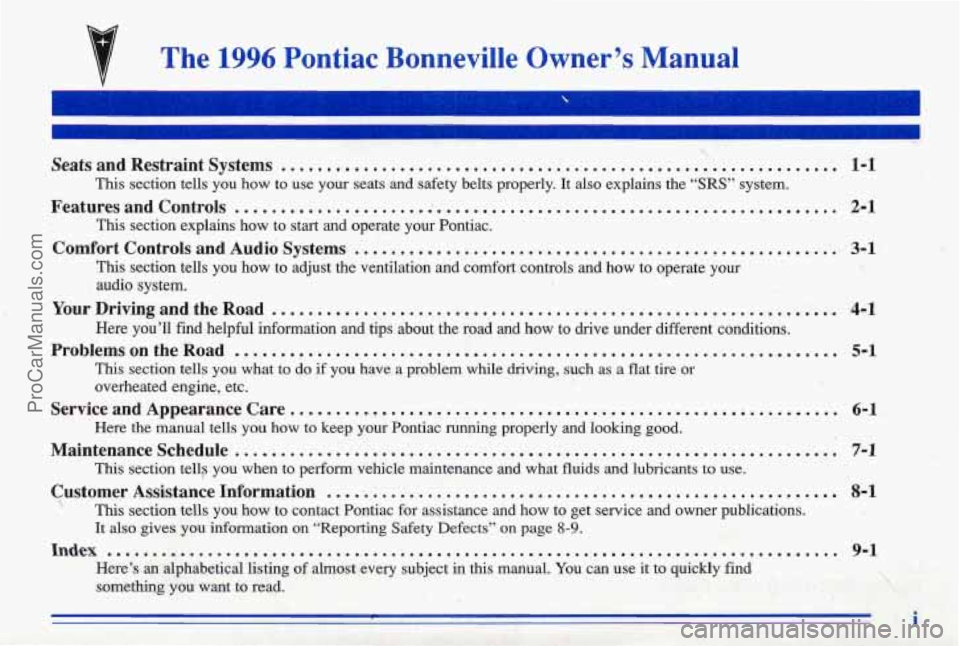
The 1996 Pontiac Bonneville Owner’s Manual
-
Seats and Restraint Systems ............................................................. 1-1
This section tells you how to use your seats and safety belts prop\
erly. It also explains the “SRS” system.
This section explains how to start and operate your Pontiac.
This section tells you how to adjust the ventilation and comfort co\
ntrols and how to operate your
audio system.
Here you’ll find helpful information and tips about the road\
and
how to drive under different conditions.
This section tells you what to do if you have a problem while driving, such as a flat tire or
overheated engine, etc.
Here the manual tells
you how to keep your Pontiac running properly and looking good.
This section tellp you when to perform vehicle maintenance and what \
fluids and lubricants to use.
This section tells you how to contact Pontiac for assistance and how to get service and \
owner publications.
It also gives you information on “Reporting Safety Defects”\
on page 8-9.
Here’s an alphabetical listing of almost every subject in this manual. You can use it to quickly find
something
you. want to read.
Features and Controls ..................... ; ............................................ 2-1
Comfort Controls and Audio Systems ...................................................... 3-1
. Your Driving and the Road .............................................................. 4-1
ProblemsontheRoad
.................................................................. 5-1
Service and Appearance Care.. .......................................................... 6-1
Maintenanceschedule......... .......................................................... 7-1
Customer Assistance Information ... .#. ................................................... 8-1
Index ........................................................................\
.......... 9-1
ProCarManuals.com
Page 6 of 387
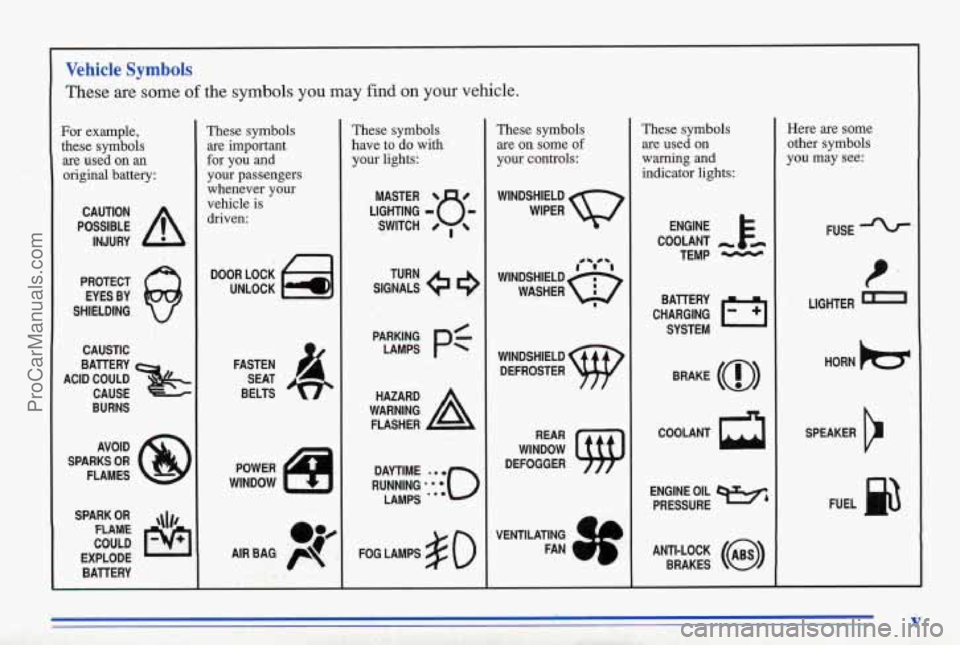
Vehicle Symbols
These are some of the symbols you may find on your vehicle.
For example, these symbols are used on
an
original battery:
POSSIBLE A
CAUTION
INJURY
PROTECT EYES BY
SHIELDING
CAUSTIC
BURNS AVOID
SPARKS
OR
FLAMES
SPARK
OR ,\I/,
COULD
RAM€
EXPLODE BATTERY
These symbols are
important
for you and
your passengers whenever your
vehicle
is
driven:
f-l DOOR LOCK
UNLOCK
FASTEN SEAT
BELTS
e?
AIR BAG p
These symbols
have to do with your lights:
SIGNALS e
TURN
PARKING
p$ LAMPS
FOG LAMPS
$0
These symbols are on some of
your controls:
WIPER Q
WINDSHIELD
DEFROSTER
VENTILATING
FAN - )
These symbols are used on
warning
and
indicator lights:
ENGINE
COOLANT
- e-
TEMP -
CHARGING I-1
BATTERY
SYSTEM
BRAKE
(0)
COOLANT a
ENGINE OIL e,
PRESSURE
ANTI~LOCK (@)
BRAKES
Here are some
other symbols
you
may see:
FUSE
LIGHTER
m
HORN )tr
SPEAKER
b
FUEL p3
v
ProCarManuals.com
Page 57 of 387
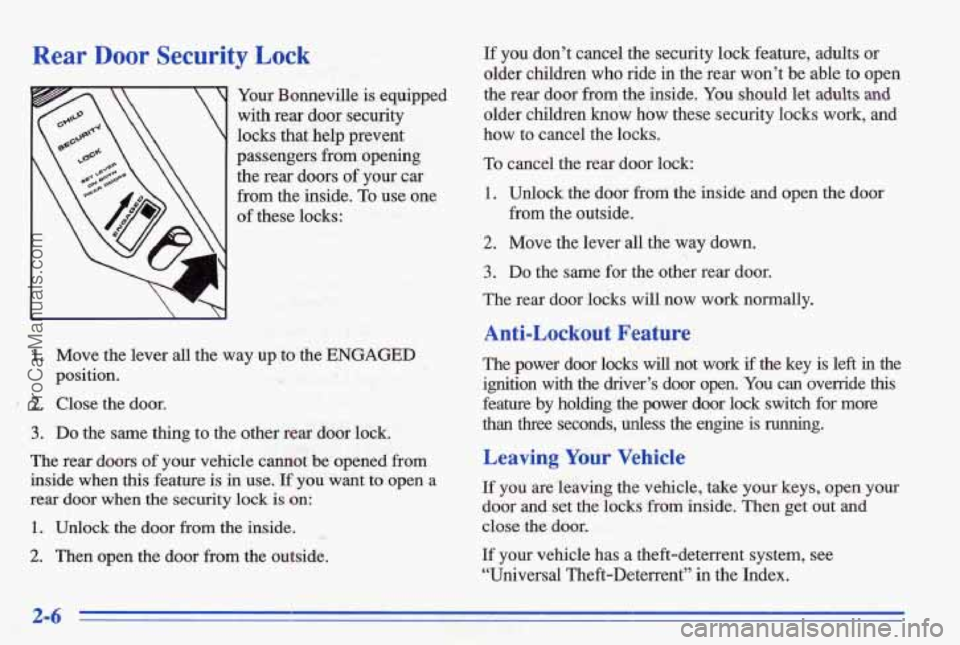
Rear Door Security Lock
c
Your Bonneville is equipped
with rear door security
locks that help prevent
passengers from ,opening
the rear doors
of your car
from the inside.
To use one
of these locks:
1. Move the lever all the way up ,to the ENGAGED
position.
3 2. Close the door.
3. Do the same thing to the other rear door lock.
The rear doors of your vehicle canhot be ’opened fkom
inside when this feature is in use.
If you want to open a
rear door when the security lock is on:
1. Unlock the door fkom the hide.
2. Then open the door from the outside.
If you don’t cancel the security lock feature, adults or
older children who ride in the rear won’t be able to open
the rear door
from the inside. You should let adults and
older children know how these security locks work, and
how to cancel the locks.
To cancel the rear door lock:
1. Unlock the door fiom the inside and open the door
from the outside.
2. Move the lever all the way down.
3. Do the same for the other rear d’oor.
The rear door locks
will now work normally.
Anti-Lockout Feature
The power door locks will not work if the key is left in the
imsm with the driver’s door open. You can override this
feature by holding the power door lock switch for more
than three seconds, unless the engine is running.
Leavhg Yuur Vehicle
If you are leaving the vehicle, take your keys, open your
door and set the locks from inside. Then get out and
close the door.
If your vehicle has a theft-deterrent system, see
“Universal Theft-Deterrent” in the Index.
2-6
ProCarManuals.com
Page 63 of 387

Remote Trunk Release Lockout (Option)
The trunk release lockout valet switch in the trunk
allows you to secure items in the trunk. By pressing the
left side
of the valet switch, the remote trunk release
button below the driver’s door armrest will be disabled.
Push the right side
of the valet switch to enable the
remote
trunk release button to work again.
-, Trunk Security Override (Option)
‘: .’ Psessing the trunk symbol on the remote trms~xktter
,. . opens the trunk even if the remote trunk release lockout
switch
is activated.
Trunk Lid
It can be dangerous to drive with the trunk lid
open because carbon monoxide
(CO) gas can
come into your vehicle, You can’t see or smell
CO. It can cause unconsciousness and even death,
If you must drive with the trunk lid open or if
electrical wiring or other cabl’e connections must
pass through the seal between the body and the
trunk lid:’
Make sure all windows are shut.
0 Thrn the fan on your heating or cooling
system to its highest speed with the setting
on
ECON or VENT. That will force outside
air into your vehicle. See “Comfort
Controls” in the Index.
If you have air outlets on or under the
instrument panel, open them all the
way.
See “Engine Exhaust” in the Index.
ProCarManuals.com
Page 66 of 387
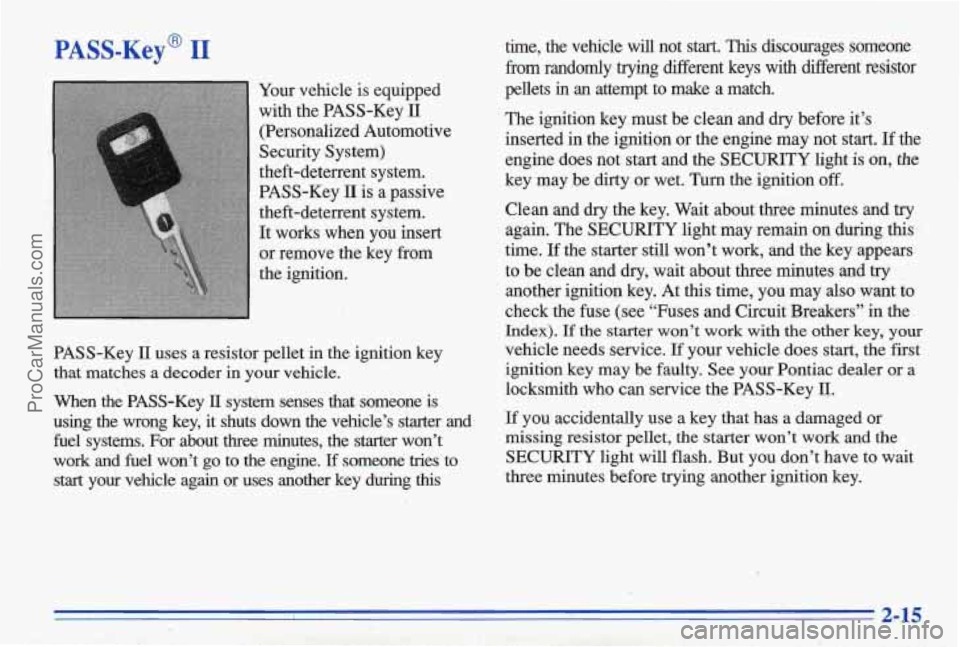
PASS-Key@ I1
Your vehicle is equipped
with the PASS-Key
II
(Personalized Automotive
Security System)
theft-deterrent system.
PASS-Key
II is a passive
theft-deterrent system.
It works when you insert
or remove the key from
the ignition.
PASS-Key
II uses a resistor pellet in the ignition key
that matches a decoder
in your vehicle.
When the PASS-Key
11 system senses that someone is
using the wrong key, it shuts
down the vehicle’s starter and
fuel systems. For about three minutes, the starter won’t
work and fuel won’t go to
the engine. Lf someone tries to
start your vehicle again or uses another key during
this
time, the vehicle will not start. This discourages someone
fiom randomly trying different keys with different resistor
pellets
in an attempt to make a match.
The ignition key, must be clean and dry before it’s
inserted in the ignition
or the engine may not start. If the
engine does not start and the SECURITY light
is on, the
key may be dirty or wet. Turn the ignition off.
Ciean and dry the key. Wait about three minutes and try
again. The SECURITY light may remain on during this
time. If the starter still won’t work, and the key appears
to be clean and dry, wait about three minutes and try
another ignition key. At this time, you may also want to
check the fuse (see “Fuses and Circuit Breakers” in the
Index). If the starter won’t work with the other key, your
vehicle needs service. If your vehicle does start, the first
ignition key may be faulty.
See your Pontiac dealer or a
locksmith who can service the PASS-Key
Q.
If you accidentally use a key that has a damaged or
missing resistor pellet, the starter won’t work and the
SECURITY light will flash. But you don’t have to wait
three minutes before trying another ignition key.
! 2-15
ProCarManuals.com
Page 67 of 387
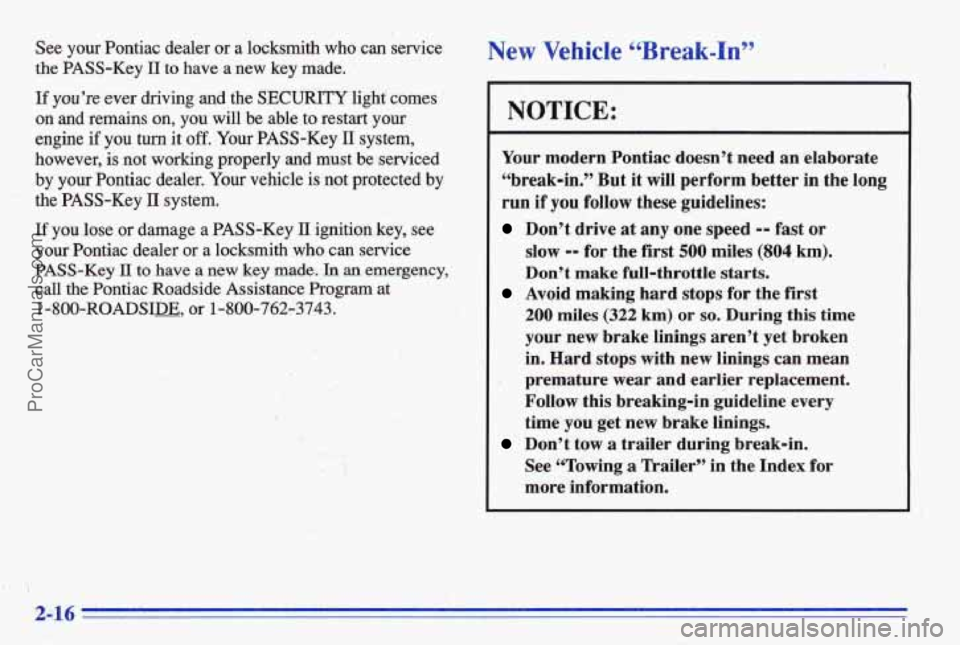
See your Pontiac dealer or a locksmith who can service
the PASS-Key
IT to have a new key made.
If you’re ever driving- and the SECURITY light comes
on and remains on, you will be able.to restart your
engine
if you turn it off. Your PASS-Key 11 system,
however, is
not working properly and must be serviced
by your Pontiac dealer.
Your vehicle is not protected by
If you lose or damage a PASS-Key II ignition key, see
your Pontiac dealer
OT a locksmith who can service
PASS-Key 11 to have a new key made. In an emergency,
call the Pontiac Roadside Assistance Program
at
1-800-ROADSID3, or 1-800-762-3743.
. the PASS-Key II system.
New Vehicle (LBreak-In99
NOTICE:
P
Your modern Pontiac doesn’t need an elaborate
“break=in?’.But
it win perform better in the long
run if you follow these guidelines:
Dm’t drive at any one speed. -- fast or
slow
-- for the first 500 miles (804 km).
Don’t make full-throttle starts.
200 miles (322 km) or so. During this time
your new brake linings aren’t yet broken
in. Hard stops with new linings
can mean
premature wear
and earlier replacement.
Follow
this breaking-in- guideline every
time youmget new brake linings.
See ‘cTowing
a flrailer” in the Index for
more information.
Avoid making hard. stops for the first
Don’t tow a trailer during break-in.
2-16
ProCarManuals.com
Page 68 of 387
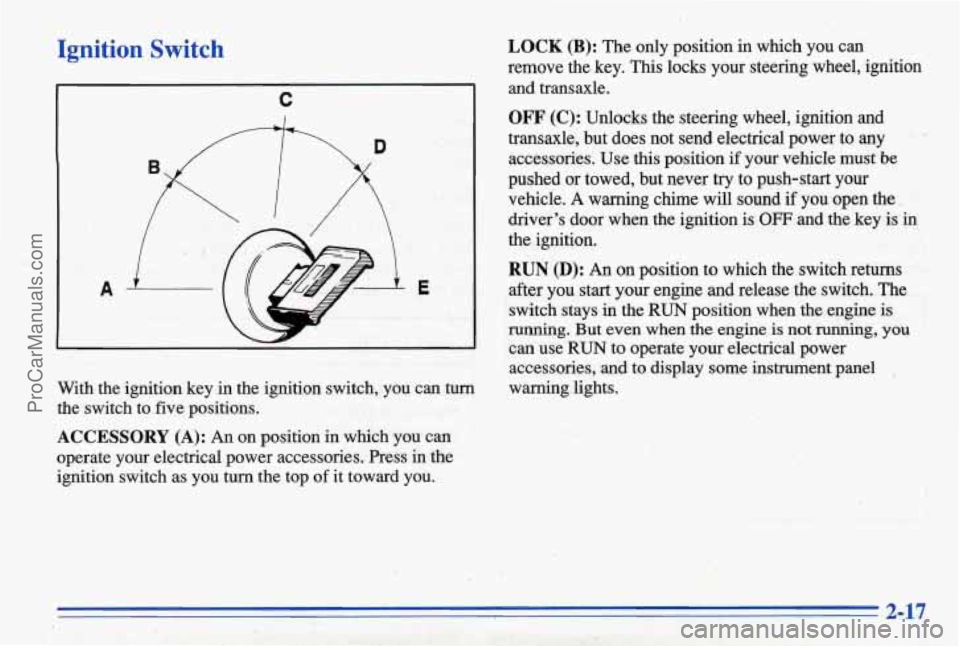
Ignition Switch
C
With the ignition key in the ignition switch, you can turn
the switch to five positions.
ACCESSORY (A): An on position in which you can
operate your electrical power accessories. Press in the
ignition switch
as you turn the top of it toward you.
LOCK (B): The only position in which you can
remove the key. This locks your steering wheel, ignition
and transaxle.
OFF (C): Unlocks the steering wheel, ignition and
transaxle, but does not send electrical power to any
accessories.
Use this position if yoUr vehicle must be
pushed or towed, but never try to push-start your
vehicle.
A warning chime will sound if you open the,.
driver's door when the ignition is
OFF and the key is in
the ignition.
RUN (D): An on position to which the switch returns
after you start your engine and release the switch. The
switch stays
in the 'RUN position when the engine is
running. But even when the engine is not running, you
can use RUN to operate your electrical power
accessories,
and to display some instrument panel
warning lights.
2-17
ProCarManuals.com
Page 69 of 387
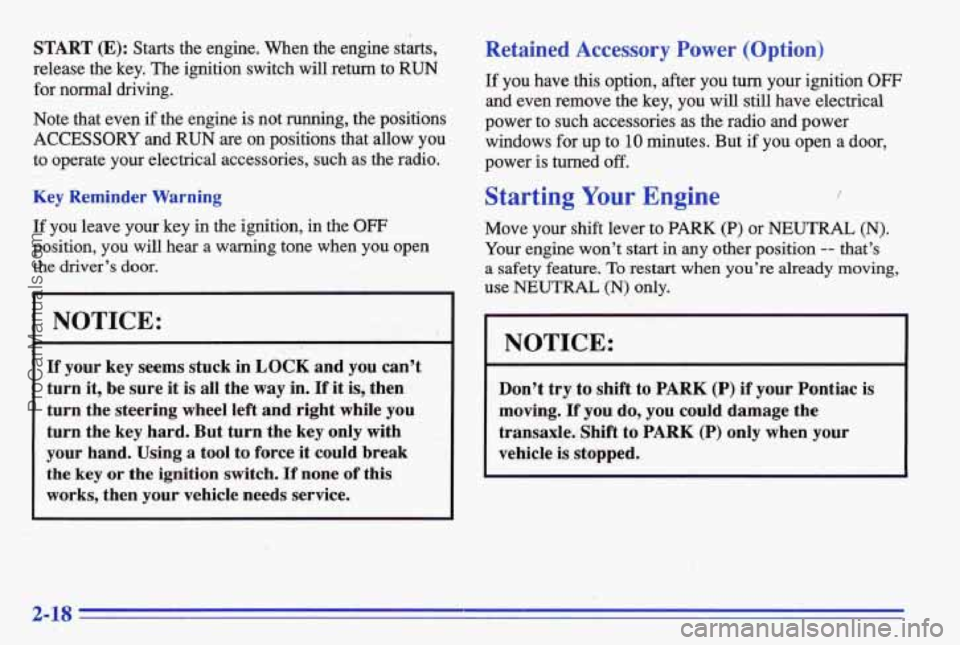
START (E): Starts the engine. When the engine st&&
release the key. The ignition switch
will return to RUN
for normal driving.
Note that even if the engine
is not running, the positions
ACCESSORY and RUN are on positions that allow you
to operate your electrical accessories, such as the radio.
Key Reminder Warning
If you leave your key in the ignition, in the OFF
position, you will hear a warning tone when you open
the driver’s door.
NOTICE:
If your key seem stuck in LOCK and you can’t
turn it, be sure
it is all the way in. If it is, then
turn the steering wheel left and right while you
turn the key hard. But turn the
key only with
your hand. Using a tool to force it could break
the key or the ignition switch.
If none of this
works, then your vehicle needs service.
Retained Accessory, Power (Option)
If you have this option, after you turn your ignition OFF
and even remove the key, you will still have electrical
power to such accessories
as the radio and power
windows for up to 10 minutes. But if you open a door,
power is turned off.
Starting Your ,Engine
Move your shift lever to PARK (P) or NEUTRAL (N).
Your engine won’t start in any other position -- that’s
a safety feature. To restart when you’re already ‘moving,
use NEUTRAL (N) only.
NOTICE:
Don’t try to shift to PARK (P) if y& Ponthc is
moving. If you do, you could damage the
transaxle. Shift to PARK (P) only when your
vehicle
is stopped.
2-18
ProCarManuals.com